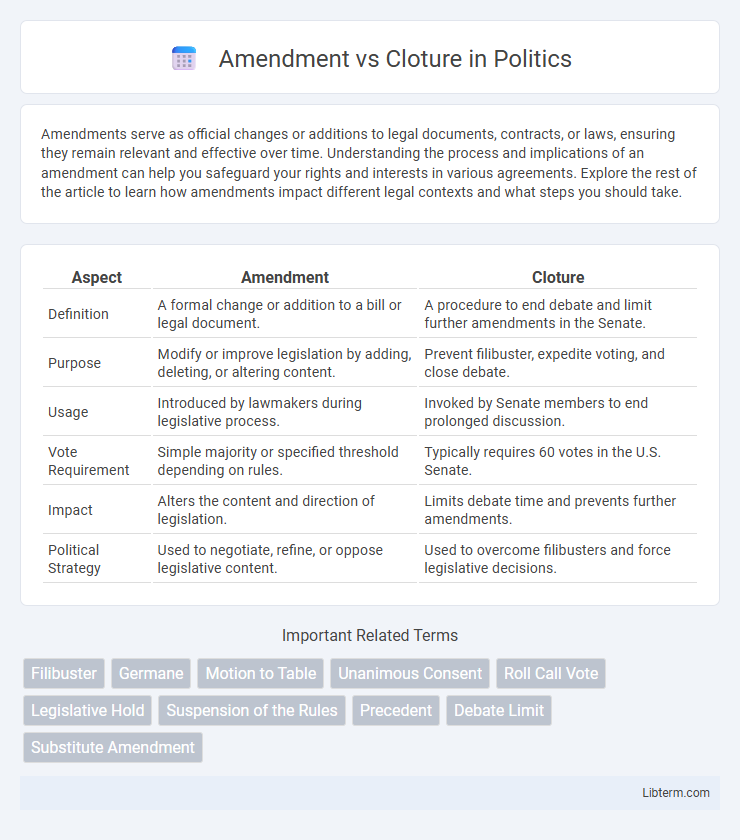Amendments serve as official changes or additions to legal documents, contracts, or laws, ensuring they remain relevant and effective over time. Understanding the process and implications of an amendment can help you safeguard your rights and interests in various agreements. Explore the rest of the article to learn how amendments impact different legal contexts and what steps you should take.
Table of Comparison
| Aspect | Amendment | Cloture |
|---|---|---|
| Definition | A formal change or addition to a bill or legal document. | A procedure to end debate and limit further amendments in the Senate. |
| Purpose | Modify or improve legislation by adding, deleting, or altering content. | Prevent filibuster, expedite voting, and close debate. |
| Usage | Introduced by lawmakers during legislative process. | Invoked by Senate members to end prolonged discussion. |
| Vote Requirement | Simple majority or specified threshold depending on rules. | Typically requires 60 votes in the U.S. Senate. |
| Impact | Alters the content and direction of legislation. | Limits debate time and prevents further amendments. |
| Political Strategy | Used to negotiate, refine, or oppose legislative content. | Used to overcome filibusters and force legislative decisions. |
Understanding Amendments: Definition and Purpose
Amendments are formal changes or additions proposed to a bill or legislative motion to clarify, improve, or modify its content before final approval. They allow lawmakers to refine the details of legislation to better address policy goals or constituent needs, ensuring more precise and effective laws. Understanding amendments is crucial for grasping how legislative bodies adapt and negotiate proposals during the law-making process.
Cloture Explained: Breaking Legislative Deadlock
Cloture is a procedural motion in legislative bodies designed to end debate and overcome filibusters, requiring a supermajority vote, often three-fifths, to pass. While amendments introduce changes to bills or motions to refine legislation, cloture specifically targets legislative deadlock by limiting further discussion and moving the process toward a vote. Cloture empowers legislatures like the U.S. Senate to break prolonged debates, streamline decision-making, and maintain efficient legislative workflow.
Amendment vs Cloture: Key Differences
Amendment and cloture serve distinct functions in legislative processes; an amendment proposes changes or additions to a bill, influencing its content and scope. Cloture is a procedural motion used to end debate on a bill, effectively overcoming a filibuster and moving the legislation toward a final vote. The key difference lies in their purpose: amendments modify legislation, while cloture limits debate to expedite decision-making.
The Amendment Process in Legislative Bodies
The amendment process in legislative bodies allows members to propose changes or additions to a bill, enabling detailed examination and refinement of the legislation. Amendments typically undergo debate and vote, with rules varying by chamber to control the number and type of modifications permitted. Cloture, in contrast, is a procedural motion used primarily in the Senate to end debate on a bill or amendment, requiring a supermajority vote to limit further discussion and move toward final passage.
How Cloture Functions in Parliamentary Procedure
Cloture functions in parliamentary procedure as a mechanism to end debate and move forward to a vote, effectively overcoming a filibuster. It requires a supermajority vote, typically three-fifths or 60 senators in the U.S. Senate, to invoke cloture and limit further discussion to 30 additional hours. This process ensures that legislative action is not indefinitely stalled by prolonged debate, balancing the minority's right to debate with the majority's ability to legislate.
Historical Cases: Amendments and Cloture in Action
Historical cases of amendments and cloture highlight significant Senate battles shaping U.S. legislation. The 1917 Senate cloture rule, established during World War I, ended filibusters to pass the Selective Service Act, marking a pivotal use of cloture. Amendments like the 1964 Civil Rights Act faced numerous proposed changes, showcasing the strategic use of amendments to modify or delay legislation before cloture votes ended debate and moved bills forward.
Strategic Use of Amendments versus Cloture
Amendments serve as a tactical tool to modify or delay legislation by introducing changes that can reshape policy outcomes or stall progress. Cloture is strategically employed to end debate and overcome filibusters, limiting amendments and accelerating legislative votes. Lawmakers use amendments to negotiate or obstruct, while cloture enforces procedural discipline to ensure timely decision-making.
Impact on Legislation: Amendment vs Cloture
Amendments directly alter the content of a bill, enabling lawmakers to modify, enhance, or restrict legislative measures, thereby shaping policy outcomes. Cloture, by contrast, primarily affects the legislative process by curtailing debate and preventing filibusters, allowing the Senate to proceed to a final vote more efficiently. While amendments influence the substance of legislation, cloture impacts the timing and progression, ultimately affecting how and when laws are enacted.
Rules Governing Amendments and Cloture
Rules governing amendments allow members to propose changes to legislation, typically requiring recognition by the presiding officer and adherence to debate limits set by the chamber's rules. Cloture rules aim to end debate on a pending matter, requiring a supermajority vote--usually 60 senators in the U.S. Senate--to limit further amendments and bring the issue to a final vote. These rules balance minority rights to amend legislation with the majority's ability to prevent extended debate or filibuster.
Amendment and Cloture: Implications for Lawmakers
Amendments allow lawmakers to modify proposed legislation by adding, deleting, or changing text, which can shape policy outcomes and reflect negotiated compromises. Cloture is a procedural motion used to end debate on a bill or amendment, limiting filibusters and expediting the legislative process by requiring a supermajority vote, typically 60 out of 100 senators. Understanding the dynamics between amendments and cloture is crucial for lawmakers to balance thorough debate with timely decision-making in the Senate.
Amendment Infographic

 libterm.com
libterm.com